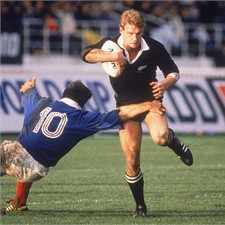Rugby World Cup magic and miscellany
Kicking off a new series, Ian Gilbert unearths some historical gems to reel off and impress your mates in the coming weeks as Rugby World Cup 2011 in New Zealand fast approaches.
The winning side on 23 October will lift the Webb Ellis Cup – but how did it get its name?
The story of William Webb Ellis, a scholar at England’s Rugby School in the 19th century, is, like all good yarns, woven with a few strands of fable. Legend has it that Webb Ellis “with a fine disregard for the rules of football ... took the ball in his arms and ran with it”.
Historians demur whether this was the pivotal moment of rugby’s genesis, but Webb Ellis certainly attended the school – and his gravestone, in a cemetery at Menton, France, chronicles the account of his deviation from accepted round-ball rules.
Do the players reap rewards other than the kudos of victory?
Rugby union turned professional shortly after the 1995 World Cup, so in the first three tournaments players were amateur. Since then, they have been able to profit from their prowess – Australia have been promised a AUS$110,000-a-man (£70,000) bonus by their union should they win a record third World Cup.
And if they don’t?
In 2007 the Wallabies’ quarter-final defeat cost them a tournament bonus – which would have kicked in had they made the last four. Spare a thought for the Romanian team in the 1987 tournament; after an unimpressive showing, their federation suspended 12 players for up to a year for lack of commitment.
So the New Zealand and France players in the first Rugby World Cup final didn’t get a cent for their efforts?
No, but several of the stars of that first Rugby World Cup final are still heavily involved in the game. On the Kiwi side, wing John Kirwan has forged a coaching career with Italy and now Japan. Talismanic number 8 Wayne Shelford coached English side Saracens and now has the reins of Auckland club North Shore, while flanker Michael Jones coached Samoa from 2004-2007.
Hooker Sean Fitzpatrick is a regular TV pundit, as is Philippe Sella, who lined up in the French midfield that day. Pierre Berbizier, France’s scrum half that day, coached the national XV as well as club sides and is now at the helm of Top 14 side Racing Metro 92.
Serge Blanco, whose silky running from full back was a feature of the first tournament, is president of Biarritz, while fly half Franck Mesnel is chairman of a clothing brand which kits out England, France and Wales with their off-field formal wear.
The first international rugby match was played in 1871, between Scotland and England. Why did it take until 1987 to hold a World Cup?
The idea of a Rugby World Cup wasn’t new, but it wasn’t until the 1980s that the idea gained serious momentum. (Rugby did feature in four Olympics in the early part of the 20th century, making its final appearance at the 1924 Paris Games.)
Previously, the Five Nations (as it was prior to Italy’s inclusion in 2000) was the pinnacle of the game for the European sides (together with Lions tours for British and Irish players), and the Bledisloe Cup for Australia and New Zealand.
Apartheid-era South Africa was in the international wilderness, although it had a vote on the International Rugby Football Board, as the IRB was known. Tours also indicated the world pecking order, such as when Australia completed a Grand Slam of Britain and Ireland in 1984.
Despite New Zealand and Australia strongly advancing the case for a World Cup, there was concern from some quarters a World Cup would threaten the game’s amateur status. In a 1985 secret ballot in Paris, however, the game’s heavyweights reached accord and the Rugby World Cup was born.
Well, blow me down!
When a blast of the referee’s whistle signals the kick-off for New Zealand v Tonga on 9 September, it will mark the continuation of a Rugby World Cup tradition. The same whistle has been used to start the opening match of every Rugby World Cup, while a single florin has been used for the coin toss at those fixtures.
The whistle was used by Welsh referee Gil Evans for the 1905 All Blacks tour to Britain and Ireland, who later presented it to compatriot Albert Freethy. The latter used it to officiate in the rugby final of the 1924 Olympic Games and again for New Zealand against England at Twickenham in 1925.
It was at that game New Zealand supporter DC Gray lent Freethy a coin for the toss, later having it embossed with a rose and a fern to mark its significance. Outside of Rugby World Cups, the two items are kept at the New Zealand Rugby Museum in Palmerston North.
Coming next ... the whole kit and caboodle
